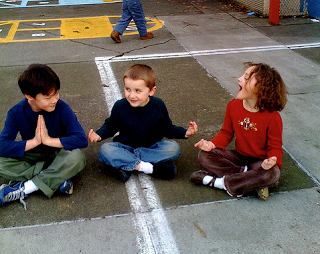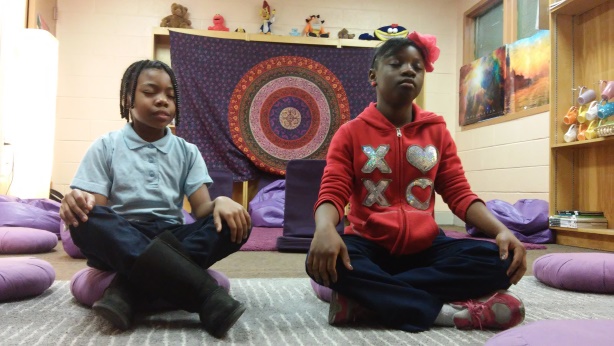| Compassion Tool |
 |
|
Help Validate CEI's Compassion Scale. Enter a drawing for Amazon Gift Cards.
Follow this link:
|
| Mindfulness |
 |
|
|
| Cyberbullying |
 |
|
|
|
|
 |
Dear Educators,
2018. We are almost two decades into the 21st Century, and technological advances continue. We now have Alexa taking orders, Siri forecasting the local weather, and Google Assistant bringing Bach to your kitchen. And there are scalable platforms for autonomous driving, drones, and self-driving bots. However, a visit to almost any classroom or school would see little evidence of transformations in how we approach the instruction of our children -- including few changes in our approach to discipline.
One of the most promising shifts in discipline that is growing in popularity is the "mindfulness moment room." Backed by substantial evidence documenting the effectiveness of mindfulness, schools are taking a few deep breaths and stepping away from punishments and turning to reflective contemplation. In this month's
Wow!, Joanna Marzano and Marah Barrow give us some insight from how mindfulness is being implemented in schools in Baltimore and San Francisco. And on the international scene, Morgan Grant reviews Asian children's books on compassion and grit.
|
 |
Minding the Way We Discipline
By Joanna Marzano, CEI Intern |
 What
What would happen if, instead of punishing children for their misbehavior with detention and demerits, we helped them understand where their behavior was coming from, and taught them how to change it? Schools across the country have been doing just that by incorporating mindfulness into their daily routines and using it as an alternative solution for misbehavior.
Conventional school discipline such as suspension and detention have negative effects on students and teachers, including decreased graduation rates and post-secondary school enrollment (Winkler, Walsh, Blois, Mare, & Carvajal, 2017). High suspension rates also correlate with students reporting lower feelings of connectedness to their school. Recent studies have shown that new forms of behavioral correction, ones that help to integrate the misbehaved students back into the school community rather than isolating them from their peers, need to be put into place (Winkler et al., 2017). This need for a wholesome and integrative approach to discipline is likely why mindfulness instruction---defined as teaching students to pay attention on purpose, in the present moment, non-judgmentally-- is being incorporated into many of our schools.
Putting Ideas into Action
 Mindful Moments in Baltimore. Mindful Moments in Baltimore. The Holistic Life Foundation is a Baltimore-based non-profit dedicated to bringing mindful skills to students in underprivileged communities. They have had an influence in over 42 schools in the Baltimore area, Patterson High School being one of them. At Patterson High, instead of sending kids to detention for misbehaving, teachers refer them to the Mindful Moment Room. In this room, students are assigned to a mindfulness instructor and have a focused discussion for about 5 minutes and mindful practice and breathing exercises for 15 minutes. Implementation of the Mindful Moment program reduced classroom suspensions from 36 in 2012-2013 to 17 in 2013-2014 (Holistic Life Foundation, 2016).
Sustained mindful practice can help students recognize when an emotion is arising during a given situation. Students are then more likely to mindfully respond, rather than automatically react to emotions. Automatic reactions are commonly charged with anger or frustration, which is a basis for conflict and misconduct. Mindfulness may also have a positive impact on students by helping them shift their attention from distracting stimuli and impulses to what is being taught in class (Felver, Doerner, Jones, Kaye, & Merrell, 2013). Sustained practice can shift attention to psychological, emotional, and physiological reactions to stimuli, thus altering the way students experience and respond to stimuli in a positive manner. It can help students remain focused and aware of what is happening within them and outside of them, increasing both their quality of life and the quality of everyone's learning experience.
 To create an environment that fosters mindfulness throughout the entire school daily, rather than only using it for disruptive behavior, Patterson High also offers full mindfulness classes lasting 60-90 minutes.
- These classes teach students conflict resolution, how to enhance concentration, how to become more aware of their thoughts and emotions, self-regulation, and stress reduction.
- Students report that they are using the skills they learn in these classes at home, in class, and with their relationships with others.
- Some students enjoy the practice of mindfulness so much that they choose to become "ambassadors" and learn to lead their own mindfulness classes.
Bringing mindfulness into Patterson High School has created an environment where students are more compassionate and understanding of their peers, teachers, and themselves. A little bit can go a long way, which is not surprising when you take a look at all the research that demonstrates just how powerful mindfulness can be.
The Benefits of Mindfulness
Mindfulness meditation has reduced stress levels and increased self-regulation in individuals across many populations, including those with depression, anxiety, ADHD, and demanding jobs with high levels of burn-out. This, in turn, promotes higher levels of well-being and performance in work and school (Felver et al., 2013, Vickery & Dorjee, 2016). Mindfulness is defined as paying attention on purpose, in the present moment, non-judgmentally. Although most of the research on mindfulness has been focused on adult populations, a shift towards a focus on children has developed over recent years.
Mindfulness interventions have shown to improve metacognitive skills like emotional- and self-regulation in both children and adults (Vickery & Dorjee, 2016). Metacognitive skills are vital for one's ability to think and learn effectively, with high levels of metacognition increasing student's levels of attention, behavioral inhibition, and grades (Zelazo & Lyons, 2012). High levels of metacognition not only help students perform better in class; it provides them with valuable cognitive tools that they can hold onto for the rest of their lives.
In a study conducted by Vickery and Dorjee (2016), an 8-week mindfulness intervention given to 71 children aged 7-9 during school hours showed a significant decrease in negative affect and a significant increase in meta-cognition. Students were recruited from 3 primary schools in North Wales. The intervention was broken down into 30-minute sessions to accommodate the needs of most school schedules and 76% of students reported that they enjoyed the intervention with a desire to continue practice. This study is a great example of:
- The effectiveness of mindfulness in primary schools for better control of emotions and cognition
- The ability for mindful interventions to accommodate even the busiest of class schedules
- A positive reaction from students.
21st Century Learning
Mindfulness teaches us how to control overwhelming emotions and urges, and how to accept the things in our lives that might otherwise upset us deeply. Children entering the 21st century require a new way of learning to keep up with our rapidly expanding technology and society. Mindfulness could provide them with the unique skills necessary for the future: the power to control and utilize our thoughts and emotions in ways that are most effective. We have the ability to think for ourselves, but so often we enter "auto-pilot" and act in unproductive ways. The power of our minds is what sets us apart from the sophistication of our technology, and it is about time we learn how to use it to its fullest potential.
References
Felver, J. C., Doerner, E., Jones, J., Kaye, N. C., Merrell, K. W. (2013). Mindfulness in school psychology: applications for intervention and professional practice.
Psychology in the Schools, 50.6, 531-547.
Winkler, J. L., Walsh, M. E., de Blois, M., Maré, J., & Carvajal, S. C. (2017). Kind discipline: Developing a conceptual model of a promising school discipline approach.
Evaluation and Program Planning, 62, 15-24.
Zelazo, P. D., & Lyons, K. E. (2012). The potential benefits of mindfulness training in early childhood: A developmental social cognitive neuroscience perspective.
Child Development Perspectives, 6(2), 154-160.
|
 |
A Teacher's Best Friend-- How Mindfulness Can End the Cycle of Ineffective Punishment
By Marah Barrow, CEI Intern |

Suspension, detention, positive behavior interventions, behavior charting-- the list is endless when it comes to strategies teachers and administrators implement in an effort to reduce unwanted behaviors.
Who knew that the solution didn't end in "ion"? Rather, mindfulness -- an initiative resulting in improved student behavior through the use of breathing techniques, emotional support, and personal responsibility--has taken hold in several school districts, putting traditional disciplinary techniques to shame. In essence, with mindfulness, students learn to consider the present moment in a non-judgmental way. They learn to be mindful of themselves and others. Skeptical? Is this just another temporary solution cooked up by people who have never stepped foot in a classroom? Well, let's let the results speak for themselves.
Mindfulness in San Francisco. San Francisco schools have been implementing mindfulness in the form of "quiet time" at the behest of Superintendent Richard Carranza who has encouraged its district wide use. Following its first use in the district in 2007, Visitacion Valley Middle School saw marked improvement in multiple areas, including decreasing suspension rates by 45 percent, increased attendance, and measurable improvements in overall student happiness (Kirp, 2014).
 In Baltimore. In Baltimore. San Francisco is not alone. In Baltimore, Robert W. Coleman Elementary School has created an environment where traditional discipline no longer has a home, at least not a permanent one. Rather than suspending students who have a momentary lapse in judgement, causing them to miss valuable class time, Coleman is able to emphasize mindfulness strategies as an effective alternative. Students are able to escape into the "Mindful Moment Room" where they can deal with their emotions in a healthy and lasting way. Patterson High School, also located in Baltimore, has seen similar results with a substantial decrease in school suspensions from 46 to 26 over the course of one school year (St. George, 2016).
Teaching Students Strategies for Coping
Students come to school to learn, but often find themselves consumed by problems at home or other stresses. By using mindfulness techniques, teachers are able to crack the code, so to speak (St. George, 2016). So much class time is wasted when teachers are forced to punish the transgressions of their students, without addressing the underlying concerns, which leads to unnecessary tension (Schwartz, 2017) and failure to help students find solutions to their turmoil and more positive ways to express themselves. Mindfulness, on the other hand, helps students learn useful techniques to deal with the specific situations, as well as applicable solutions to other stressful or confrontational situations they may face.
So, where can you get this magic solution? What strategies are working so well in these schools? Commonalities of mindfulness can be found in all of the success in CA and MD and include:
- Meditation
- Emotional Support
- Controlled Breathing
- Self-Awareness
 These results don't just look good on paper. In a Child Mind Institute article, teacher Kristina Suter attests to the power of mindfulness in her classroom. As a special education teacher, she understands the emotional stress, and fast paced responses forced on both students and teachers alike. By giving her students the tools they need to express their emotions in a healthy manner, she is able to focus on the task at hand rather than being faced with the impossible choice of dealing with a behavior concern or teaching the material with which she has been tasked (Garey, 2017).
Teachers aren't the only ones raving about the effectiveness of mindfulness in avoiding perpetual disciplinary measures. Students impacted by the program are not silent (CBS, 2017). Students report that they are better able to focus on maintaining their emotional well-being, which also results in a more positive attitude towards academics.
What is Different about Mindfulness?
Why is this different? Rather than putting a band-aid on the problem, mindfulness deals with the root of the issue, and changes the behavior at its core. Students participating in the mindfulness program are taught social skills, decision making, problem avoidance, responsibility, appropriate stress response, character development, and the list goes on. Unlike suspension, detention, and the other temporary solutions to behavioral concerns, mindfulness creates a lasting change that students can carry with them far beyond their time in the classroom. Some might even consider mindfulness to be their new best friend.
References
|
 |
Grit, Compassion, and Self-Acceptance; Lessons Taught by Asian American Children's Stories
By Morgan Grant, CEI Intern |
Children's books with Asian American characters, values and themes can be used to teach a variety of lessons such as grit, compassion and self-acceptance. Using this
medium, educators can talk about everyday values ranging in complexity in a way that children can relate and understand. Incorporating books from
multi-cultural backgrounds introduces a diverse prospective, reinforces a child's own cultural roots and helps to build empathy towards others. Storytelling has also been found to foster critical thinking and improve listening and communication skills (Packham, 2017; Shah, 2017). We have reviewed nine Asian American children's stories that can be a resource for reinforcing interpersonal and intrapersonal skills.
Grit.
Grit is an important personality trait that helps children persevere through various challenges. Learning about how others have endured hard times can help motivate and inspire children, especially if they identify with the story's main character (Craycroft, 2017). Grit is a popular theme within Asian American children's literature and many stories focus on topics related to courage, overcoming personal adversity and issues/conflicts with immigration.
- Yuko Chan and the Daruma Doll by Sunny Seki
Yuko Chan is an adventurous girl who doesn't let her disability stop her from being a leader in her community. Although Yuko is blind, she does not let the viewpoint of others discourage her from saving her village. Yuko's motto is based on the words of a wise village monk, "If you fall seven times, you must pick yourself up eight times" (Seki, 2012).
- Barbed Wire Baseball by Marissa Moss and Yuko Shimizu
 Barbed Wire Baseball is based on a true story of Kenichi Zenimura (Zeni), a Japanese-American boy who grew to become a professional baseball player, despite being told he was "too small" to play when he was younger. After the attack on Pearl Harbor, Zeni, like many Japanese Americans, was forced to live in Internment Camps during World War II. Despite the various hardships of the camp, Zeni is still determined to play baseball one way or another (Moss & Shimizu, 2013). Barbed Wire Baseball is based on a true story of Kenichi Zenimura (Zeni), a Japanese-American boy who grew to become a professional baseball player, despite being told he was "too small" to play when he was younger. After the attack on Pearl Harbor, Zeni, like many Japanese Americans, was forced to live in Internment Camps during World War II. Despite the various hardships of the camp, Zeni is still determined to play baseball one way or another (Moss & Shimizu, 2013).
- In the Year of the Boar and Jackie Robinson by Bette Bao Lord
In the Year of the Boar and Jackie Robinson is about a Chinese girl, Shirley Temple Wong, who recently immigrated to America. Shirley is worried that she will not be able to adapt and makes friends in America because she does not speak English. Shirley's interest for baseball grows as she admires Jackie Robinson for his resolve to play the game, regardless of his critics. Shirley is then inspired to adapt to her new life in New York (Lord, 2003).
Compassion. Empathy is an essential component needed for school children to successfully interact with others. Reinforcing the idea that it is okay for others to be different increases pro-social behavior in children. Children who are empathetic are also more likely to adjust positively. Books that focus on compassion and empathy can teach children that bullying and excluding others is harmful (Packham, 2017).
- Sumi's First Day of School Ever by Soyung Pak and Joung Un Kim
Sumi is a Korean girl who knows little English and is afraid that she will be alone at her first day of school in America. After she is teased about the shape of her eyes by a boy in her class, Sumi is discouraged from making any friends. After her negative encounter, her teacher and classmates decide to step up to the plate to make her feel welcomed (Pak & Kim, 2003).
Crow Boy is about Chibi, a young boy who is a shy outcast in elementary school and is labeled as strange by his peers. The other teachers and students believe that Chibi is slow and stupid and as a result they begin to exclude him. His viewpoint of school changes when a new teacher shows him compassion and raises his self-esteem by supporting his secret talent (Yashima, 1976).
- A Path of Stars by Anne Sibley O'Brien

A Path of Stars is about a girl named Dara whose grandmother, Lok Yeay, frequently reminisces about her pre-war life in Cambodia prior to immigrating to the United States. Her grandma's dream is to one day have the entire family including Dara to visit Lok Yeay's brother in Cambodia. When Dara finds out that some unfortunate circumstances ruin her grandma's dream she comes up with a plan. Dara decides to bring Cambodian culture and traditions to ease her grandmother's broken spirit (OBrien, 2012).
Self-Acceptance. School aged children begin to familiarize themselves with concepts such as "same" and "different" and this can translate to how they interact with their peers. Many school children feel pressure to act and look similarly to their peers in order to feel accepted. Sometimes children from a
different culture or a lifestyle that is not reflected by the majority can feel alone and isolated. Valuing one's differences and their country/culture of origin is important for a
positive self-concept (Maffei, 2017).
- The Name Jar by Yangsook Choi
 The Name Jar The Name Jar is about a new student from Korea, Unhei, who moves to America. She is afraid her name will be too hard for her peers to pronounce. She decides to introduce herself without a name and tells her classmates that by the end of the week she will choose a name via their suggestions. Towards the end, with the help of her classmates, a community member and a friend, Unhei learns to accept her name and to take pride in it (Choi, 2003).
- Suki's Kimono by Chieri Uegaki and Stéphane Jorisch
Suki is a Japanese-American who is very proud of her heritage and wants to wear her kimono to the first day back to school, despite it not being popular. While others tell her not to wear the kimono and some of her peers think its "funny looking," Suki is determined to be herself anyways (Uegaki & Jorisch, 2003).
- The Year of the Book by Andrea Cheng and Abigail Halpin
The Year of the Book is about Anna Wang, a young girl who must balance her life between elementary school and her weekend Chinese Language School. Anna has trouble fitting in at school and is embarrassed by her mother's low English skills. Anna feels like she does not fit in anywhere and feels that the only place where she belongs is in her books. Eventually Anna realizes that fitting in isn't what truly matters and accepts her mother and herself the way she is (Cheng & Halpin, 2012).
References
Cheng, A., & Halpin, A. (2012).
The year of the book. New York, NY: Scholastic Inc.
Choi, Y. (2003).
The name jar. New York, NY: Dell Dragonfly Books.
Pak, S. & Kim, J. U. (2003).
Sumi's first day of school ever. New York, NY: Viking Press.
Lord, B. B. (2003).
In the year of the boar and Jackie Robinson. New York, NY: HarperCollins.
Moss, M. & Shimizu, Y. (2013).
Barbed wire baseball: How one man brought hope to the Japanese internment camps of WWII. New York, NY: Abrams Books for Young Readers.
OBrien, A. S. (2012).
A path of stars. Watertown, MA: Charlesbridge.
Seki, S. (2012).
Yuko-chan and the Daruma doll. Tokyo, Japan: Tuttle Publishing.
Uegaki, C. & Jorisch, S. (2003).
Suki's kimono. Tonawanda, NY: Kids Can Press.
Yashima, T. (1976).
Crow boy. London, England: Puffin Books.
|
|
|
2018 - A Mindful Year
As 2018 begins, it may well be a good time to take stock, and look again at your school discipline policies and procedures. In the 21st Century, it's past time to replace suspensions, expulsions, and in-school punishments with strategies such as mindfulness that are designed to help individuals overcome anger and hostility and become more aware of how to help themselves and others.
Sincerely,
Christine Mason
Center for Educational Improvement |
|
|